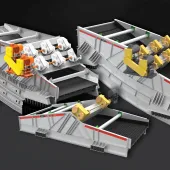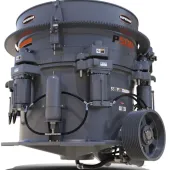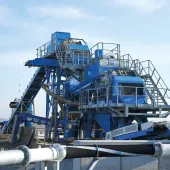CDE launch R-Series primary screens

New R1500 and R2500 machines designed to optimize feed to CDE’s turnkey wash plants
CDE Global have announced the launch of their R-Series range of primary screens, which have been designed to optimize feed to the company’s turnkey wash plants and reduce the requirement for a dedicated operator to feed the processing plant.
The new range includes two new machines – the R1500, which has a maximum feed capacity of 200 tonnes/h, and the larger R2500 machine (pictured), which offers a maximum feed capacity of 500 tonnes/h. Both machines are said to be suitable for use in the pre-screening of a range of materials including crushed rock, sand and gravel, C&D waste, coal and topsoil.
The R-Series combines a feed hopper, screen and conveyors in a variety of different configurations. The feed hopper on the R1500 has a maximum capacity of 7 tonnes when fitted with optional extendable hopper sides, while the hopper capacity on the R2500 unit rises to 20 tonnes. Both machines can be equipped with either a belt feeder or an apron feeder, and the hopper has been designed to allow for the feed to be delivered from three sides for maximum flexibility depending on specific site conditions.
Commenting on the R-Series, Stewart Cusick, product development engineer at CDE Global, said: ‘The R-Series allows for a constant, even flow of material to be delivered to the integrated screen, before being sent for additional screening, washing and sizing. The hopper capacity – particularly on the R2500 machine – allows for charge filling of the hopper which frees up an operator and vehicle to complete other jobs on site, ultimately reducing the level of operator intervention required with the processing plant.’
Kevin Vallelly, product development manager at CDE, explained that the R-Series was developed as an efficient delivery system when more difficult materials are being processed. ‘Whether it’s C&D waste material or clay-bound crushed rock, we’re increasingly helping our customers design systems that are able to process more challenging materials,’ he said.
‘A key part of ensuring your processing plant performs at maximum efficiency with minimum operator intervention is getting the feed system right, and we spent more than two years developing the R-Series, including extensive testing at sites in Ireland, the UK, Germany and Scandinavia on a wide variety of different materials.’
The R-Series sees the introduction of two new galvanized Infinity screens from CDE, both of which include new patented side-wall technology which eliminates welds and results in a stronger, lighter screen which is said to produce the same acceleration as traditional screens while using less power. The R1500 includes the Infinity P1-36R screen, which measures 2.4m x 1.5m (8ft x5ft), while the R2500 integrates the Infinity P2-75R screen, which measures 5m x 1.5m (16ft x5ft).
‘The basis for the Infinity screen design was to screen better, last longer and cost less to run,’ explained Mr Vallelly. ‘The only assumptions we made from a design perspective were that the screen needed to be rectangular and have one, two or three screen decks. It is able to screen better because of design features such as the Rosta suspension mounts, which ensure maximum transfer of energy to the material.
‘We eliminated welds from the side walls and the screens are galvanized as standard to deliver on the promise to last longer. It’s our patented design of the side walls that allows us to ensure the screen is strengthened where it needs to be without including unnecessary weight. This allows us to produce a screen that requires less power to run.’
Many other design features on the Infinity screens are a result of the ‘screen better, last longer, cost less to run’ design philosophy. The cartridge design of the screen decks, for example, maximizes plant life as it increases the durability of otherwise welded joints. The Infinity range also includes cast U-Span cross-members, which are also weld free and significantly reduce floor flex.
‘In addition to the extensive on-site testing that our equipment goes through, we use many other virtual testing programmes during the design phase, including finite element analysis,’ explained Mr Vallelly. ‘This gives us confidence in our design and ensures that when it gets to on-site testing, it’s only final tweaks and minor changes that are required.’
Further weight has been removed from the screen thanks to the special design of the screen shaft, which reduces the mass of the shaft assembly while still generating the same force as a solid shaft, while extensive use of replaceable wear liners at every feed and impact point maximizes plant life and includes such features as a magnetic polyurethane cover on the screen shaft, tapered rubber chutes at the screen discharge point and easy-to-replace steel wear plates in the R-Series feed hopper.
The R-Series machines utilize SKF bearings with a special double-seal arrangement to reduce the risk of material and water ingress during operation. Site safety has also been considered with the raising of the side walls of the screen to prevent rogue rocks from bouncing off the top deck of the screen. The two machines in the R-Series also include 800mm galvanized walkways to ensure site operators have quick, easy and safe access for essential machine inspection and maintenance.
Stockpiling and delivery of material to additional processing phases is facilitated by the inclusion of 9m (30ft) feed/stockpile conveyors in a variety of configurations, depending on the specific requirements of a project. The 9m (30ft) stockpile conveyor for oversize material allows for a stockpile capacity of 150 cubic metres (196 cubic yards). The R-Series also includes a collection conveyor beneath the Infinity screen which delivers material to an additional stockpile conveyor or directly to the feed boot of the M2500 or M4500 modular washing plants.









